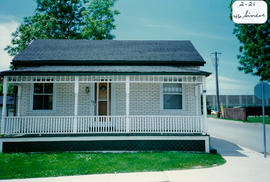- CA BWGPL GJ-HB-2017-04-21-06
- Unidad documental simple
- 1996
Parte deGeorge Jackson fonds
The building located at 46 Simcoe Road (on the corner of Thomas St. and Simcoe Road) was built pre-1900 in the Ontario Vernacular Cottage style. James Church, and then Jimmie Jackson, his wife, and son once lived in this house. Jimmie worked for the town, was a noted drain expert, and did road work. Mrs. Jackson remained in the house for many years after her husband died. It was also once the home of Lorne Faris (a jeweller) and his wife (Ona). Lorne converted the shed that was on the property into a garage. John Kanyo Jr. lived here when he was first married. After the Kanyo family, it became the home of Budd Robson. Years later, Mr. and Mrs. Emerson Madill (retired farmers from the south side of the 10th Concession near Highway 400) resided here.
The one-storey, three-bay ‘cottage’ has a simple form with a symmetrical façade, a rectilinear plan, and a shallow-pitched, gable roof. It has a centre hall entrance from a covered, open, front-entrance porch which is accessed from the side. Originally, the porch stairs were in the centre and aligned with the front door. The hip roof on the porch is supported on turned posts. Decorative, wood fascia is found at the porch roof. There is a plain, wood handrail and balusters and the porch foundation is enclosed with wood lattice. The building has narrow window openings with low floor to ceiling heights. Windows are set into rectangular openings with plain, wood trim and sills. The house has wood frame construction with brick cladding and a parged, concrete foundation. Originally, the cladding was stucco. According to the 2000 inventory, the house is in good condition with some original features that have been maintained well. (1, 2, 3)
Sin título


